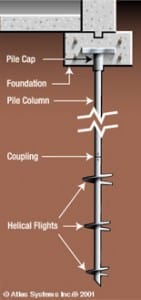How a helical pier works – Take Flight part 2
How a Helical Pier Works
In part one of this discussion, we talked about what a helical flight is.This post will hopefully add some insight into how torque equates to loading in helical piers. We will also discuss one of the HUGE blunders of a local. Helical piers are screwed in by a hydraulic gear motor. This motor generates a hydraulic pressure on the gear that equates to a torque (force) on the pier being installed. This torque is then multiplied by a soil factor (when soil testing is done there is an actual number defined for the soil and for the product, when soil testing is not performed a generic ‘average’ is used). For the purposes of this post lets use the following equation (used from a technical manual written by Don Clayton, PE) –
Ultimate Capacity = Torque x “k”
where “k” is equal to the soil multiplication factor.
This is a simple equation, and to give an example for a light duty pier – we generally install our helical piers to 4,500 ft/lbs and use a standard average soil factor of 8.
Capacity = 4,500 x 8 = 36,000lbs ultimate capacity
since the ultimate capacity on a single flight is between 40,000-50,000 lbs (steel and weld capacity) – a contractor could use a single flight configuration for this loading.
Now for the HUGE blunder by a local manufacturer. Let’s review some details of helical piers:
Torque is one of the main factors of the ultimate capacity of piers.
Helical pier types can handle different torques (thicker pipe = stronger, etc)
Flights have an ultimate capacity of 40,000 lbs for the flights – but the pier torque is what generates the ultimate capacity.
I have run across the situation where a standard residential pier (.203 wall) is sold as a high capacity pier (60,000-70,000 lb ultimate capacity) by the salesman telling the contractor that he’ll just add another flight to the pier. If you double the flights you do add additional capacity, but the problem is – You simply cannot install a standard residential pier to the torque required to generate 60,000-70,000 lbs. The pier will fail during installation – remember the equation
Capacity = Torque x “k” where “k” is the soil factor.
60,000 = Torque x 8
60,000/8 = Torque = 7,500 ft/lbs
Typical residential piers can be installed to around 5,500 ft/lbs – max. You cannot get there from here no matter how many flights you add to the pier shaft (in fact you will notice the equation doesn’t even factor in the number of flights). But I’ve seen this, and I’ve seen general contractors buy this lie from the local company “engineer”. Just because someone says the pier will hold that capacity doesn’t mean it can’t or won’t sink.





